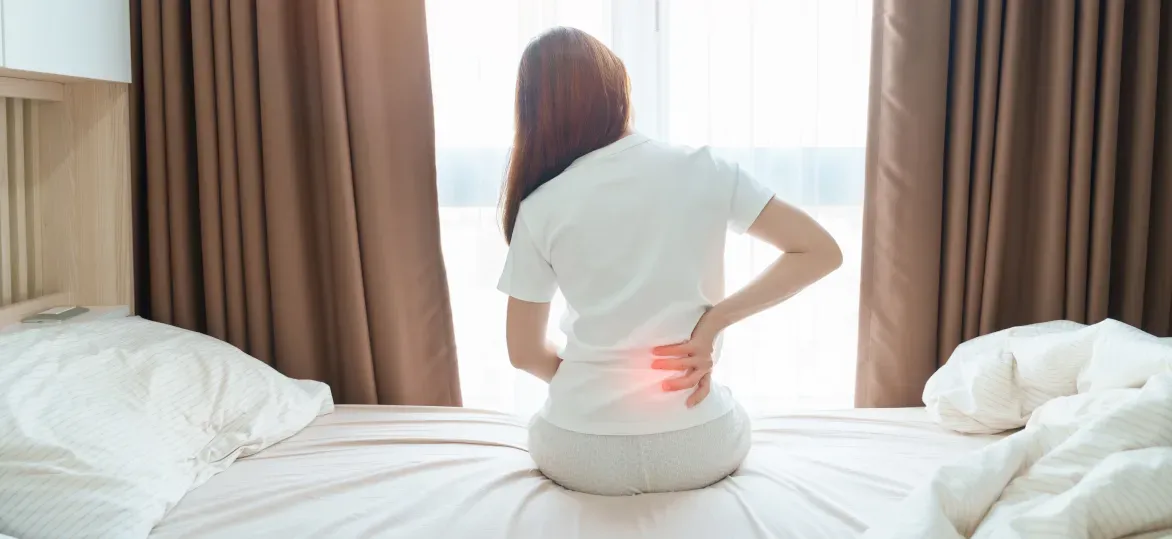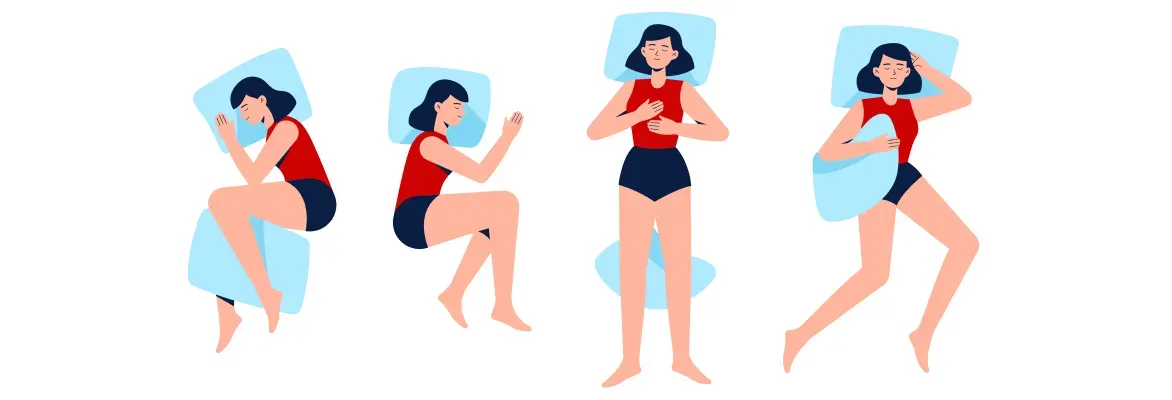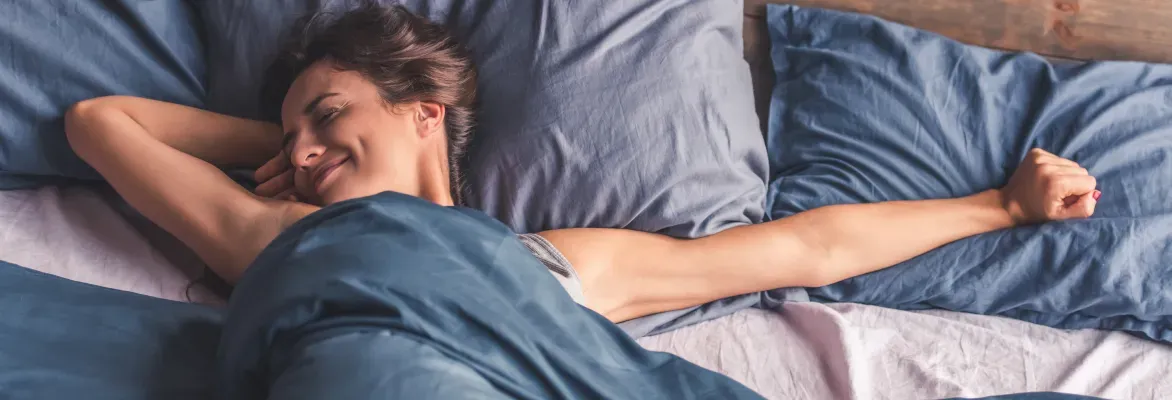How To Sleep With Lower Back Pain
Fri Jul 12 2024
- Sleep Tips
Are you struggling to find comfort at night due to lower back pain? You're not alone. According to the National Institute of Health, about 80% of adults experience lower back pain at some point in their lives.
Many find that this discomfort significantly disrupts their sleep quality.
In this guide, we'll explore practical strategies to help you sleep better despite lower back pain, as well as some tips for choosing between mattresses for sale with a focus on pain relief and spinal support.

Understanding Lower Back Pain and Sleep
The relationship between lower back pain and sleep quality is a complex and often frustrating one. Many find themselves caught in a challenging cycle where discomfort disrupts rest, and poor sleep worsens pain.
Chronic sleep deprivation can have profound effects on overall well-being. Research has shown links to weakened immune function, making individuals more susceptible to illness. Most alarmingly, prolonged sleep issues have been associated with an elevated risk of cardiovascular problems.
Research has shown that sleep and pain have a bidirectional relationship. Pain can make falling and staying asleep difficult, while lack of sleep can increase pain sensitivity. This connection is partly due to sleep's role in pain modulation and the body's natural healing processes.

Best Sleeping Positions for Lower Back Pain
Finding the right sleeping position can relieve lower back pain and improve your sleep quality. Let's explore some of the most effective positions:
1. Side Sleeping with a Pillow Between Knees
Side sleeping can be helpful for those with lower back pain, as long as you side-sleep with proper spine alignment. This position helps reduce stress on the lower back.
How to do it:
1. Lie on your side with your knees slightly bent.
2. Place a pillow between your knees to keep your hips, pelvis, and spine in alignment.
3. For added support, put a small pillow or rolled towel in the curve of your waist.
Benefits:
• Reduces pressure on the spine
• Helps maintain natural spinal curvature
• Can alleviate sciatic nerve pain
2. Back Sleeping with Support Under Knees
Sleeping on your back is often considered the best position for lower back pain, as it distributes your weight evenly and minimizes pressure points.
How to do it:
1. Lie flat on your back.
2. Place a small pillow or rolled towel under your knees.
3. Use a supportive pillow for your head and neck.
Benefits:
• Maintains the natural curve of your spine
• Distributes body weight evenly
• Reduces pressure on the lower back
3. Fetal Position for Disc Pain
For those with a herniated disc, sleeping in a fetal position can help reduce pain. This position opens up the spaces between the bones in your spine, which can take pressure off the damaged disc.
How to do it:
1. Lie on your side with your knees drawn up towards your chest.
2. Gently curl your torso towards your knees.
3. Switch sides periodically to prevent imbalances.
Benefits:
• Opens up the spaces between vertebrae
• Can reduce pressure on herniated discs
• May alleviate sciatica symptoms
4. Reclined Position
For some people with lower back pain, sleeping in a slightly reclined position can provide relief.
How to do it:
1. Use an adjustable base for your bed to achieve a slight incline. We’ll get into adjustable bases later in this blog.
2. If you don't have an adjustable bed, use pillows to prop up your upper body and head.
3. Make sure your lower back is supported.
Benefits:
• Can reduce pressure on the spine
• May help with conditions like isthmic spondylolisthesis
• Can improve breathing for those with sleep apnea
Choosing the Right Mattress for Back Pain Relief
Memory Foam Mattresses
Memory foam mattresses are known for their ability to contour to your body, providing excellent support and pressure relief.
Benefits:
• Adapts to your body shape and sleeping position
• Reduces pressure points
• Isolates motion, beneficial for couples
Considerations:
• Memory foam without cooling technology retains heat
• May be difficult to move on for those with mobility issues
Hybrid Mattresses
Hybrid mattresses combine the support of innerspring mattresses with the comfort of foam layers, offering a balance of support and cushioning.
Benefits:
• Provides both support and pressure relief
• Often cooler than all-foam mattresses
• Better if you have a wide range of sleep positions
Considerations:
• Can be more expensive than traditional mattresses
• May transfer more motion than all-foam options
Adjustable Beds
An adjustable base for your bed allows you to find the perfect position to alleviate lower back pain so you get customizable support throughout the night.
Benefits:
• Allows for precise positioning to relieve back pain
• Can help with other health issues like acid reflux or snoring
• Often comes with additional features like massage functions
Considerations:
• More expensive than traditional bed frames
• May require special mattresses designed for adjustable bases

Additional Tips for Sleeping with Lower Back Pain
If you’re still experiencing back pain, some of these strategies may improve your sleep quality:
1. Use a more supportive pillow: Choose a pillow that maintains proper neck alignment to prevent additional strain on your back.
2. Practice good sleep hygiene: Establish a consistent sleep schedule, create a relaxing bedtime routine, and ensure your sleep environment is dark, quiet, and cool.
3. Try gentle stretches before bed: Light stretching can help relax tense muscles and improve flexibility. Try cat-cow stretches, knee-to-chest stretches, or gentle twists.
4. Apply heat or cold therapy: Use a heating pad to relax tense muscles before bed, or apply a cold pack to reduce inflammation.
5. Consider using a lumbar support pillow: When sitting or driving, use a lumbar support pillow to maintain proper posture and reduce strain on your lower back.
6. Stay active during the day: Regular, low-impact exercise like walking or swimming can strengthen back muscles and improve overall back health.
7. Maintain proper posture: Be mindful of your posture throughout the day, especially if you have a sedentary job.
8. Use relaxation techniques: Practice deep breathing, progressive muscle relaxation, essential oils, or sleep noises to help promote better sleep.
Upgrade Your Mattress With Bedzzz
With the right strategies and tools, managing lower back pain for better sleep is possible. Figuring out the right sleeping positions, choosing the right mattress, and implementing supportive habits can have a major positive impact on your nights.
At Bedzzz Express, we understand the importance of a good night's sleep, especially for those dealing with lower back pain. We're committed to helping you find the perfect sleep solution for your needs.
Contact us or visit one of our mattress store locations throughout Alabama and Georgia. Our knowledgeable staff can guide you through the mattress-buying process. We also offer sleep accessories like mattress toppers, mattress protectors, bed sheets, and more.
Interested in learning more? Check out these related readings from our blog:
• Discover the Health Benefits of Adjustable Bed Bases
• Tips to Improve Sleep Quality
• Mattress Quiz: What Type of Mattress Is Best for Me?
Frequently Asked Questions About Sleeping With Back Pain
How should I sleep if my lower back hurts?
If your lower back hurts, try sleeping on your back with a pillow under your knees to maintain the natural curve of your spine. Alternatively, sleep on your side with a pillow between your knees to align your spine. Avoid sleeping on your stomach, as this can strain your lower back.
How do you decompress your spine while sleeping?
To decompress your spine while sleeping, use an adjustable bed to elevate your head and feet slightly. This position can help reduce pressure on your spine. If you don't have an adjustable bed, try placing a pillow under your knees when sleeping on your back or between your knees when sleeping on your side.
What type of mattress is best for lower back pain?
The best mattress for lower back pain provides both support and comfort. Medium-firm to firm mattresses are often recommended, as they help maintain proper spinal alignment. Memory foam, latex, and high-quality hybrid mattresses can also be excellent choices, as they contour to your body while providing necessary support.
How often should I replace my mattress if I have chronic back pain?
If you have chronic back pain, consider replacing your mattress every 5-7 years or sooner if you notice sagging, lumps, or worsening back pain. A supportive mattress is crucial for managing back pain, so pay attention to how your mattress feels and replace it when it no longer provides adequate support.
Related Articles
Welcome to our website! As we have the ability to list over one million items on our website (our selection changes all of the time), it is not feasible for a company our size to record and playback the descriptions on every item on our website. However, if you are an American with a disability we are here to help you. Please call our disability services phone line at 309-691-4100 during regular business hours and one of our kind and friendly personal shoppers will help you navigate through our website, help conduct advanced searches, help you choose the item you are looking for with the specifications you are seeking, read you the specifications of any item and consult with you about the products themselves. There is no charge for the help of this personal shopper for any American with a disability. Finally, your personal shopper will explain our Privacy Policy and Terms of Service, and help you place an order if you so desire.
Copyright © 2009 - 2025 Company All Rights Reserved.
This site is protected by reCAPTCHA and the Google Privacy Policy and Terms of Service apply.
.svg)
